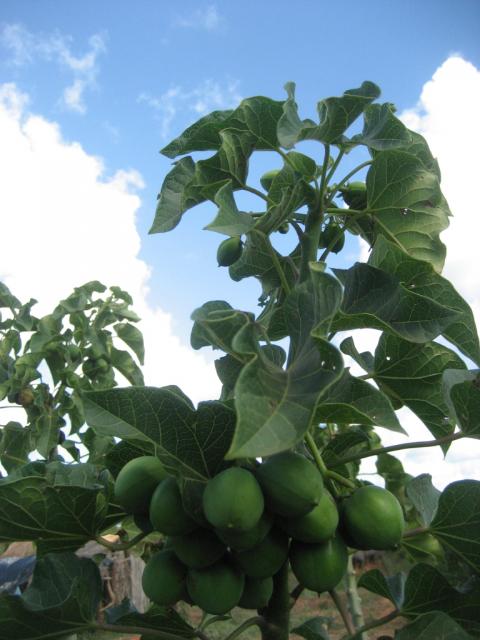This company has no active jobs
0 Review
Rate This Company ( No reviews yet )
About Us
Pests Of Jatropha

Jatropha Curcas is gaining value commercially as the need of fossil fuels increases significantly and also Jatropha is an environment-friendly energy plantation. Plantation of this plant is considered to be an exceptional fuel replacement and it is likewise extremely affordable compared to other fuels. Recently, Jatropha is dealing with some trouble with bugs and diseases. The insects are classified into two ranges: Pest that affect young plants and Pest that affect grown plants.
Young plant pests: Cutworm, Scarabeid Beetle, Army worm, Grasshopper.

Agrotis ipsilon: It is typically referred to as Cut worm. This pest affects the seedlings and young Jatropha plants. If the plant is affected by the cutworm, the stem gets cut nearer to the soil surface and this will diminished the plant entirely.
Control: This pest can be managed by selecting the larva found around the plants or by mixing the bran, sawdust with insecticides.
Scarabaeid Beetle: This pest destroys the root of the young plant. Initially, the larva consumes the raw materials present in the soil and after that pertains to the root. The larva attack may eliminate the entire plant.
Control: The plant with excellent resistance power can get rid of the insect. For heavy attack, insecticides with elements carbosulfan and carbofuran can be utilized to kill the pest.
Army worm: Spodoptera litura existence can be identified by biting in the leaves. The severe infection might totally eliminate the plants.
Control: Insecticides are utilized to control the bugs.
Grasshopper: This prevails pest discovered in several plants. Valanga nigricornis and Locusta migratoria widely assaults the plant. The bug typically attacks the young plant.
Control: The insecticides used betacyfluthrin, cypermethrin, thiodicarb, MIPC, and fipronil.
Pest observed in mature plants:
Pest of Stem: Ostrinia furnacalis, Xyleborus spp.
Ostrinia furnacalis and Xyleborus: This insect harms the Jatropha stem and it is widely seen in Indonesia. The stem assaulted by this pest usually drop. The presence can be determined by the larva penetration hole at the stem.
Control: The Insecticide typically utilized to manage this pest is carbofuran.
Pest of leaf: The typical insects observed are leaf caterpillar, Neetle caterpillar, Leaf hopper, Mite, Ear corn caterpillar.
Leaf Caterpillar: This pest can eat all the leaves of the plant in other words period. The quality and yield of the seeds get lowered due to the heavy attack.
Control: This can be controlled by choosing the old larvae around the surface area and discarding the assaulted leaves.

Needle Caterpillar: This caterpillar is covered with spinal columns and produces a burning experience when allowed to call with skin as it produces particular chemical compound. Initially the bug crowded in the leaf and after that spread out all over the plant when it ages.
Control: Manually, the pest can be killed just by soaking it in water or kerosene. The heavy attack can be controlled by spraying organophosphate insecticides.
Leaf Hopper: This bug is discovered primarily in tropical and subtropical regions. The pest targets the leaf and draws all the nutrients of the leaf and gets curls at the suggestion. Later, the entire leaf dry and die.
Control: The heavy attack can be controlled by utilizing insecticides like imidachloprid, beta cyfluthrin or carbosulfan.
Mite: Mite likewise attacks the leaf and makes the entire plant weak. The pest presence can be determined when the leaf become yellowish, diminishes, turns red and fall down. The insect can also be spread through fallen leaves.
Control: Some preventive measures can be done like proper sanitation and burning the fallen leaves. Heavy attack can be dealt with by .
Some terrible pest which assaults flower and fruit are, Stink bug (Nezara viridula)
Chrysocoris javanus, Tip borer caterpillar.
Stink Bug: Sting bug is a major bug which assaults the plant during blossom duration so the crop yield totally falls down. This insect is seen around the tropical area.
The hazardous enzyme in the plant diminishes the entire plant.
Control: Insecticides recommended for this insect is chlorfluazuron, diflubenzuron, alfamethrin, and lamda cyhalothrin.
Tip borer caterpillar: The bugs typically takes place attacks the plant in flowering season and this pest is seen extensively in tropical regions. The female pest laid the eggs on the tender part of the plant and the young larvae feed the young fruits and plant suggestions.
Control: Manually, the assaulted seeds are suggested to burn. The insecticides like monocrotophos and bensultap are sprayed at the blooming season.

